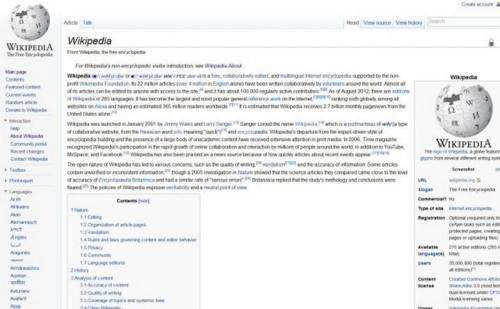The Wikipedia paradox: Who's telling the truth?

People are less likely to trust a poorly written article if the visual cues suggest it comes from Wikipedia. Presented with the same information in an alternative layout, their trust will be greater. The presence of serious factual errors has little or no effect on the trust placed in a Wikipedia article, even among experts on the subject in question. People who take a negative view of Wikipedia are less good at estimating whether an individual article is trustworthy or not. These are among the findings of the doctoral research carried out by Teun Lucassen at the University of Twente's CTIT research institute. Lucassen investigated how internet users assess the reliability of online information. He will defend his doctoral dissertation on 1 March.
Before the advent of the internet, the situation was clearer: information that appeared in print was likely to be correct because it had been checked by an editor or a journalist. But in the age of the worldwide web, anyone can easily publish all kinds of information online, leaving the user with the challenge of determining how reliable it is.
In his doctoral research, Teun Lucassen investigated how users go about assessing the reliability of the information they find online. In doing so, he focused primarily on the widely consulted online encyclopaedia Wikipedia. Lucassen believes it is a particularly good place to start because of what he calls the 'Wikipedia Paradox': everyone knows that the information on Wikipedia is generally of high quality, but because of its open structure, you can never be entirely sure of the reliability of individual articles.
New model
In several smaller-scale studies, in which he manipulated Wikipedia articles, Lucassen looked at how users assess reliability. His PhD research resulted in a new scientific paradigm: the 3S model of trust in information. On the basis of personal user characteristics – domain expertise, information skills and familiarity with the source – the model describes how users assess the reliability of individual articles.
The three S's of the model stand for semantic features (the content), surface features (how information is presented, i.e. images and references) and source features (characteristics of the source, in this study usually Wikipedia). The study shows that everyone, depending on their personal profile, uses these aspects to assess the reliability of information. However, the extent to which they use each aspect depends very much on the three personal characteristics. For example, a user with less expertise on a given topic will place greater emphasis on how the information is presented and its source.
Teun Lucassen conducted his PhD research at the CTIT research institute and the Department of Cognitive Psychology and Ergonomics at the University of Twente.
Provided by University of Twente


















